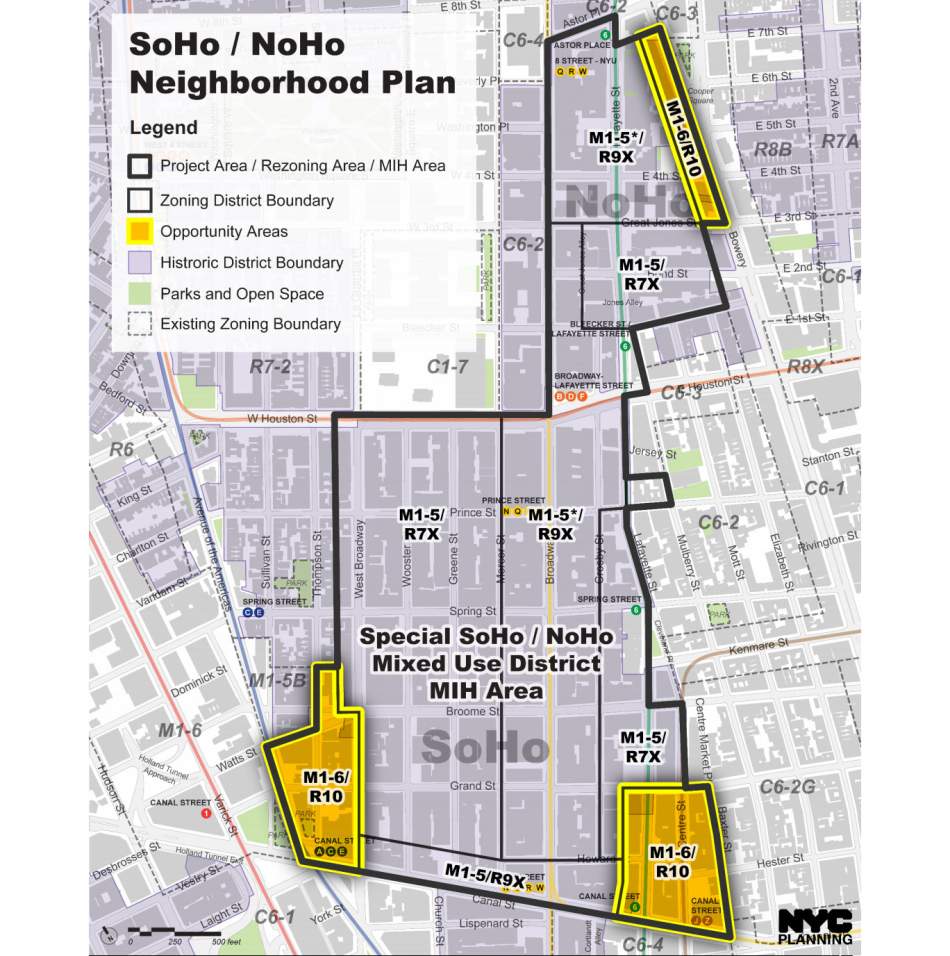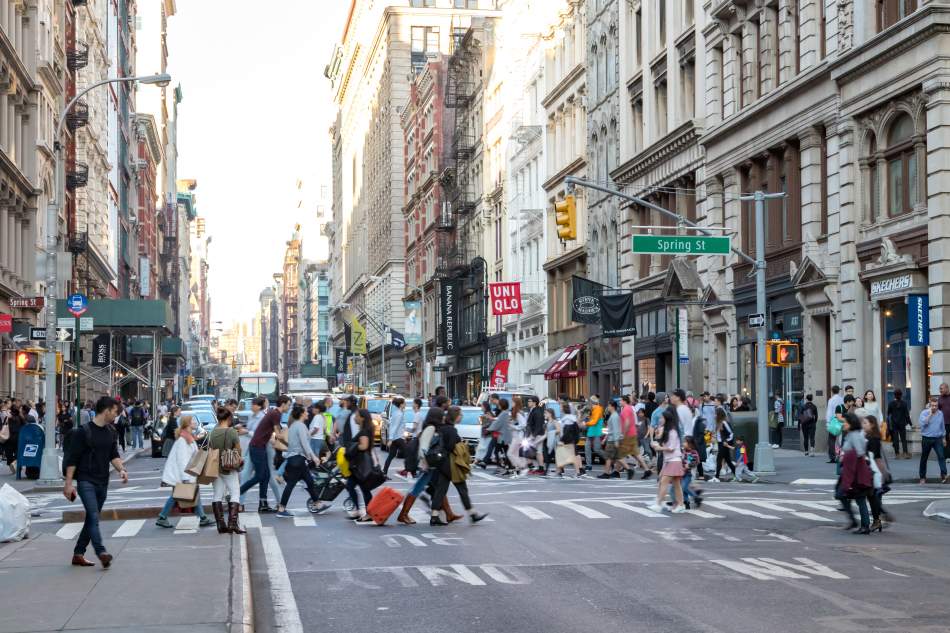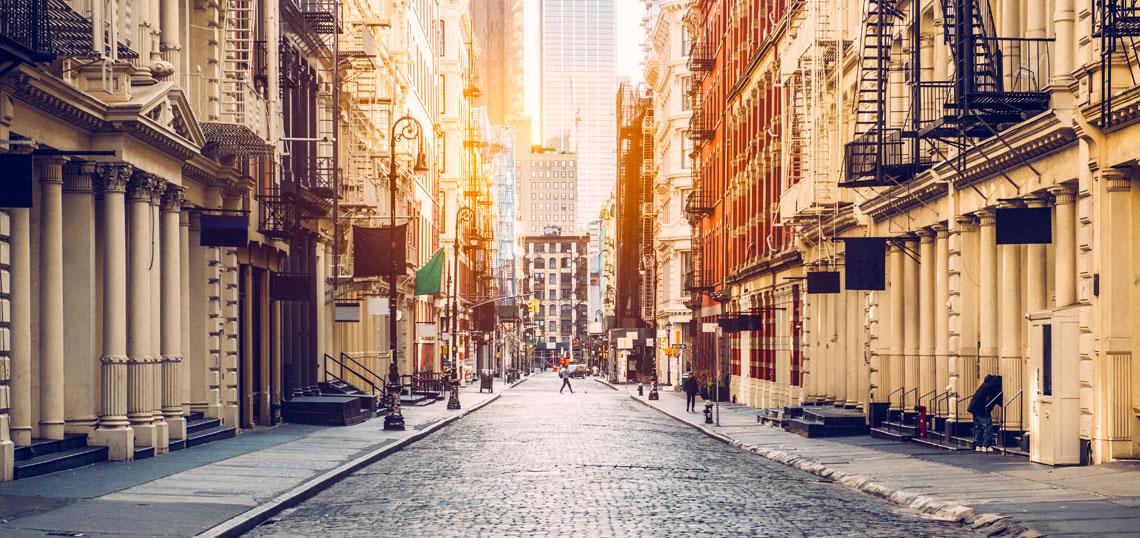In October 2020, Mayor de Blasio announced the SoHo/NoHo Neighborhood Plan, a sweeping rezoning of 56 downtown blocks that would "expand housing opportunities for New Yorkers and promote equity, support continued cultural and economic success in a holistic way and reduce regulatory burdens." The plan notably pivots away from previous rezoning efforts that have largely involved low-income areas.
While details released thus far have been largely an outline, the rezoning's focus is clear: the addition of new housing. On top of ground-up construction, existing buildings, including office and industrial space, could easily be converted to apartments under the new rules. The rezoning would, in fact, allow for another 3,200 apartments in Soho/Noho over the next 10 years, including approximately 800 affordable units.
The jump is quite staggering considering that Soho clocked in at fewer than 8,000 residents in the 2010 census. And beyond this scant figure, according to a recent study conducted by City Planning, Soho is among a handful of affluent NYC neighborhoods that have actually seen a reduction in housing over the past 10 years (2010-2020), where “unit losses significantly offset additions.”
The Neighborhood Plan would also update current commercial zoning statutes, including replacing cumbersome and costly regulations that require all new retailers to get special permission from City Planning to occupy ground-floor space. The updated rezoning would allow department stores and "physical culture establishments," such as gyms, to occupy spaces of 10,000+ square feet as of right.
Unsurprisingly, the proposed changes are being met with much local resistance — and to be sure, considerable support — for a variety of reasons.
To help make sense of some of the noise, Urbanize NYC asked David West, founding partner of Hill West Architects, for his commentary on the hotly debated topic. David is regarded as one of NYC’s foremost planning and zoning experts with over 30 years of experience. As a zoning authority, he has conducted thousands of feasibility studies and has been involved with nearly 100 completed projects, including Sky, 363 and 365 Bond Street, 101 Lincoln Avenue, 71 Reade Street, and Apthorp Penthouses. Hill West is also behind the transformative $1 billion South Bronx Bankside Master Plan.
Urbanize NYC: Where do you stand on the rezoning of Soho/NoHo?
David West: I am very much in favor of the Soho/Noho Neighborhood Plan. I’ve been designing and converting buildings of various types across New York City for more than 30 years, and in my experience, Soho has the most illogical and outdated zoning of any location in the city that I can think of. I’ve long wished that the zoning would be reformed and it’s good to see this happening now.
Soho’s zoning rules have been in place since 1970, and they were really designed to address the crisis of the fading manufacturing industry and the growing number of underutilized buildings in the area; there were many very beautiful structures that were falling into complete disrepair and that had no real economic purpose. The neighborhood was also being colonized, to an extent, by the arts, and the original zoning that was put in place (M1-5A and M1-5B, still in effect today) really only had two purposes: to legalize the use of those buildings as artist space and live-work lofts, and to preserve and maintain the endangered manufacturing industries.
This was, without doubt, a very good thing at the time, but in those 50 years, the city has changed dramatically, and Soho has changed dramatically. Today, the zoning doesn't reflect reality, and it certainly doesn’t provide opportunities for the neighborhood to be reshaped in meaningful ways.
The area in the Neighborhood Plan covers what you would consider a high-opportunity zone that’s rich in transportation and that has the potential to spur a considerable amount of growth, especially in housing and affordable housing. The current conditions are absolute anathema to that—it’s the opposite of inclusionary zoning, it’s exclusionary.
The reality is that any change that has occurred in Soho to date has occurred not because of the zoning, but in spite of it. And that's really not what zoning is supposed to do. It is supposed to guide, direct, and enable appropriate levels of growth.
Urbanize NYC: One of the most vocal opponents of the plan is Andrew Berman of the Village Preservation. He says that the plan will actually make the neighborhood “whiter, richer and more expensive,” and that the proposed rezoning favors more commercial development not residential, meaning the affordable housing generated will be thin at best (the report cites 68-103 units, rather than the 328-494 units expected over the next 10 years under the city's "worst-case scenario" projections). What are your thoughts on the figures Village Preservation has extrapolated?
David: I think the idea that a slightly higher floor area ratio (FAR) for commercial development than the base FAR for residential development will lead to more commercial buildings is just not correct. With the Mandatory Inclusionary Housing (MIH), everybody is going to build to the full residential FAR to access the inclusionary bonus, which is always the highest FAR available for a site.
This comparison isn't completely accurate and it’s not the way developers work nor think. Developers look at the value of a particular building type, irrespective of whether they can get a slightly higher FAR for some other type. It’s more about whether there is a market for a particular type of building or not.
I think the rezoning that's being proposed allows for a good, strong mix of commercial, residential, and community facilities. A neighborhood like Soho should be a mixed-use neighborhood, it shouldn’t be a residential enclave.
Urbanize NYC: The report notes that roughly 105 buildings will be at risk for the chopping block. Should we be concerned about threats to the historic fabric and the people who are in live-work situations?
David: The Neighborhood Plan will actually allow people that are currently in live-work quarters to convert those into legal residences instead of having to maintain the more restrictive statutes that are now in place—for example, as it stands now, you need to be a certified artist to keep your space. I think these existing Soho/Noho residents will be much better off and in much more secure situations with the new plan.
As far as buildings being put on the chopping block, roughly 85 percent of Soho/Noho is in a historic district, meaning any building within district bounds is virtually guaranteed protection from demolition. Moreover, any new building will be subject to Landmarks Preservation Commission (LPC) jurisdiction, and we know that the commissioners of the LPC are vigilant guardians of those historic buildings and neighborhood character. So if there are only 105 buildings in the entire neighborhood that are deemed unworthy of Landmark protection and potentially in the path of demolition, I think that's a very small number compared to all the beautiful historic buildings that will remain.
 Most of the area targeted in the rezoning plan falls within a protected historic district; The pockets shaded in yellow could sprout new buildings, though there will be height and setback restrictions
Most of the area targeted in the rezoning plan falls within a protected historic district; The pockets shaded in yellow could sprout new buildings, though there will be height and setback restrictions
You also cannot discount that this is an MIH rezoning, which guarantees that affordable housing will be added to the neighborhood. There will be opportunities created where they do not currently exist.
Right now, under the zoning that is in Soho and Noho, the rules require essentially 1200-square-foot units, which are pretty huge by New York City standards—that’s about double the size of a one-bedroom apartment in a typical rental building. This new zoning wouldn’t have those kinds of restrictions, so I think you will get a broader mix of housing, which is ultimately better for everyone.
Urbanize NYC: Speaking both in consideration of the rezoning and more generally, what should the city focus on as it tries to recover from the pandemic?
David: Well, I think first and foremost, New York City needs to reinforce itself as a place where people want to live, work, and play. Historically, the city has been just that, and I think the biggest challenge now will be bringing people back to the city’s centers.
Soho is a great place to establish a truly vibrant, mixed-use, live-work neighborhood. Taking new commercial industries, like tech, which is still flourishing in the city, into consideration with this rezoning is vital to this revitalization. At the same time, there should be more housing—and that includes more rental housing and housing for people of various incomes and needs.
We also need sustainability and resiliency, and I would say it is sustainable to reuse existing buildings because there is already a structure in place and you don't have to undertake all of the carbon-intensive work it takes to build something new. I think the Soho rezoning will be more about conversions and alterations to the existing fabric than it will be about new construction, which will be limited because there aren't very many sites left. I believe it will very much mirror what's happened in the Ladies Mile District and Tribeca.
 Broadway and Spring, pre-pandemic | Ryan DeBerardinis
Broadway and Spring, pre-pandemic | Ryan DeBerardinis
Urbanize NYC: The Independent Budget Office predicts it will take at least five years for NYC to get back to where it was economically, pre-pandemic. What do you think the return will look like in the coming years?
David: At Hill West, it has been encouraging to see that people are still planning the major development projects in the city, not only in Manhattan, but also in The Bronx, Queens, and Brooklyn away from the central business districts. Our work used to be pretty strictly limited to Manhattan and the edges of Brooklyn and Queens, and now we're excited to be moving far beyond that. The types of projects we're building are also much more geared toward creating a well-rounded life, including diverse amenity spaces and proximity to parks and other open spaces.
I think if the pandemic has taught us anything, it’s that we don't need to have everybody commit to a 9-5 job in midtown or lower Manhattan. We can have a vibrant economy that is spread more equally across the entire metropolitan area. I think this is a really good thing because it will relieve pressure on the city’s infrastructure and probably lead to a better quality of life for people in general. We will probably also see economic growth in areas that haven't seen it for many decades. These trends didn't necessarily start with the pandemic, but they will likely accelerate because of it.
Overall, I’m confident that the city's going to bounce back in a strong way. We’re going to see more of, and have more access to, all of the things that have made NYC so attractive for so long.
- Soho (Urbanize NYC)







